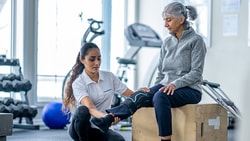Return to Sport after ACL Surgery: The Influence of Fatigue
January 4, 2016
6 min. read

Recently, a lot of attention has been paid to re-injury and return to sport following anterior cruciate ligament reconstruction (ACLR), and the results continue to be less than exceptional.
A case series of elite collegiate athletes who suffered ACL injuries prior to and during their college careers continually found difficulty returning to sports participation (Kamath et al., 2014). Of the 35 athletes who had undergone ACLR prior to enrollment in college, the rate of re-operation on the involved limb was 51.4%, the rate of re-rupture of the ACL graft was 17.4%, and contralateral ACL rupture was 20.0% within this population of athletes. Similarly, those who underwent ACLR during college had a 20.4% re-operation rate, 1.9% suffered re-rupture of the ACL graft, and 11.1% of these athletes underwent ACLR on the contralateral limb.
Compare rates for athletes who underwent ACLR before and during college| Rate of reoperation | Rate of re-rupture | Contralateral ACL Rupture | |
| Before College | 51.4% | 17.4% | 20.0% |
| During College | 20.4% | 1.9% | 11.1% |
In agreement with these findings, a prospective cohort study of 456 collegiate athletes conducted by Rugg and colleagues found that athletes entering college with a history of ACLR had a 892.9-fold increase in knee surgery compared to those who entered college without undergoing surgery.
Unfortunately, these findings are not isolated to collegiate athletes; professional (Busfield et al., 2009) and high school athletes (McCullough et al., 2012) alike have similar statistics. Considering these numbers, it points to inadequate or premature return to athletic participation, which may be because we are overlooking a very important aspect of athletic competition.
ACL Injury: Predisposing Factors
First, let's look at what factors have been shown to predispose these athletes to injury. Hewett et al conducted a prospective cohort study that identified factors that may put athletes at risk for initial ACL injury. After screening 205 female collegiate athletes with a drop-jump task, 9 athletes went on to suffer an ACL injury during the following season. These 9 athletes had several important factors in common in comparison to those who did not go on to suffer injury:
Knee abduction angle at landing was 8 greater
Knee abduction moment was 2.5 times greater
Ground reaction force was 20% higher
More importantly, the authors determined that injury could be predicted in those with an increased knee abduction moment (dynamic valgus) with 73% specificity and 78% sensitivity.
Fatigue and Biomechanics
Prior to return to sport, many athletes will undergo functional testing (hop testing, Y-Balance Test, etc.), but do these tests, done under optimal circumstances, tell the full story or are we missing something?
Fatigue has been shown repeatedly to have negative affects on lower extremity biomechanics.
A systematic review recently examined the literature pertaining to lower extremity biomechanics and neuromuscular fatigue during single-leg landings (Santamaria et al., 2010). After analyzing 8 studies and 141 total subjects, kinematic data revealed greater knee and hip flexion and increased dorsiflexion post-fatigue. More importantly, following the introduction of fatigue, there was no change in peak knee valgus angles.
However, since anticipated/practiced drop-landings are performed primarily in the sagittal plane, these specific procedures may not be sufficient to determine movement patterns during athletic competition. When an unanticipated landing was used, the results were drastically different with a significant increase in peak knee valgus angle post-fatigue compared to pre-fatigue. This unanticipated landing would seem to represent the demands of athletic competition more accurately and thus demonstrates an increased risk of injury with neuromuscular fatigue.
In agreement with these findings, Brazen et al found no change in frontal plane biomechanics during an anticipated drop-landing task after neuromuscular fatigue, however they did find a higher anterior-posterior time to stabilization (TTS) and vertical TTS, which once more increases the likelihood of injury.
Effects of Fatigue: Uninjured vs. Post-ACLR Athletes
More specific to patients following ACLR, Webster et al conducted a study comparing the response to neuromuscular fatigue between uninjured control subjects and athletes following ACLR. This study once again utilized an anticipated drop-landing task with data collected pre and post fatigue. Fatigue led to:
Reduced flexion in the lower limb
Reduced knee joint moments
Increased hip and knee abduction
Increased knee rotation
The response to fatigue was similar with no significant differences between the ACL-reconstructed limb and the control group as well as the reconstructed limb and the contralateral limb.
LESS Reveals Differences between Uninjured and Post-ACLR Athletes
To further investigate the lower extremity biomechanics of athletes following ACLR, the Lower Extremity Error Scoring System (LESS) was developed. Padua et al determined the LESS to be a valid and reliable tool in assessing jump-landing biomechanics with good inter-rater reliability (ICC= 0.84) and excellent intra-rater reliability (ICC= 0.91). This evaluation tool involves counting the number of faulty movement patterns during a jump-landing task with < 4 errors being an excellent score, 5 being good, 6 being moderate, and > 6 being poor landing mechanics.
When evaluating the influence of fatigue on LESS scores, Gokeler et al found significant differences between patients status-post ACLR and uninjured control subjects. The initial median score pre-fatigue for ACLR patients was 6.5 (poor) and 7.0 following fatigue, whereas the uninjured control subjects scored 2.5 (excellent) pre-fatigue and drastically increased to 6.0 (poor) post-fatigue.
This shows an obvious decline in movement quality following fatigue, which may place both post-ACLR patients and uninjured controls at risk for injury.
Fatigue Matters!
Fatigue is an often-neglected aspect in the decision to return an athlete to sport or to assess an athlete's initial risk for injury. This data should be used to further evolve our testing procedures to account for these potentially injurious movement patterns secondary to neuromuscular fatigue.
Albert Einstein was quoted saying, The definition of insanity is to continually do the same thing over and over expecting a different result. If we are to improve these return to sport and re-injury numbers, fatigue cannot be overlooked anymore and must be included in our clinical decision making process.
Below, watch a short patient education video explaining the ACL Tear from MedBridge's Patient Education Library.






